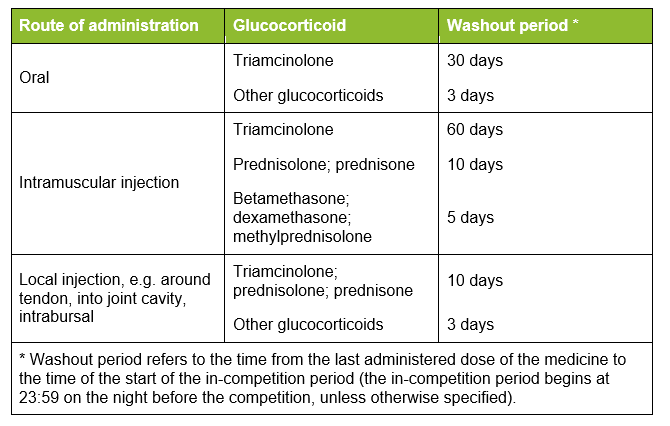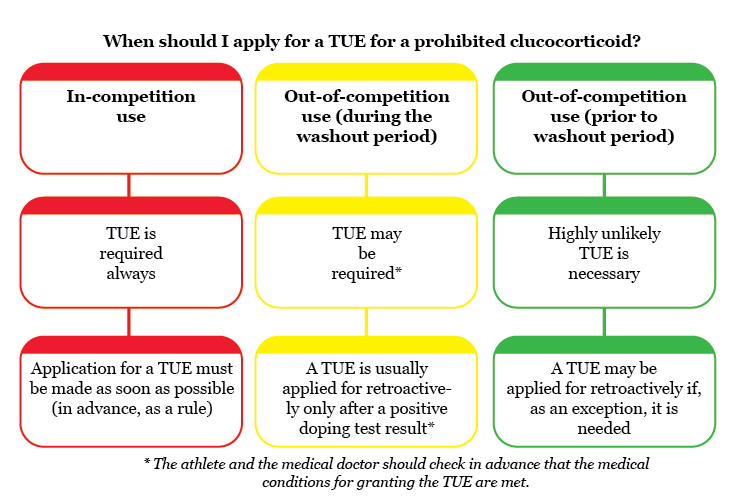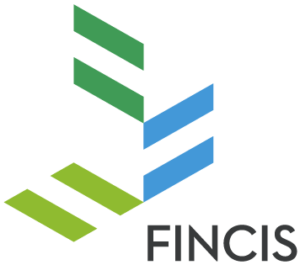The most important change to the WADA List of Prohibited Substances and Methods, effective from the beginning of 2022, concerns the use of glucocorticoids, i.e. cortisone preparations, which are prohibited in-competition. WADA has also defined washout periods for cortisone preparations and published guidelines for applying for a Therapeutic Use Exemption (TUE) for these preparations. In addition, the daily permitted dosing intervals for inhaled salbutamol used for the treatment of asthma will change.
Glucocorticoids (cortisone products) have previously been prohibited during in-competition period when the medicine has been administered orally, rectally or by intravenous and intramuscular injection. From the beginning of 2022, glucocorticoids will continue to be banned during in-competition period for oral (including oral mucosa) or rectal administration. Unlike in the past, all glucocorticoid injections, regardless of the injection site (including local injections), are prohibited during in-competition period. In the List of Prohibited Substances and Methods, cortisone preparations belong to group S9.
Washout periods for glucocorticoids
WADA has defined the washout periods for glucocorticoids according to the route of administration and the active substance when used at the doses recommended by the manufacturer. WADA has not established washout periods for rectal administration. FINCIS estimates that the washout periods for rectal administration are the same as for oral administration.
The withdrawal periods are as follows:

When does an athlete need a Therapeutic Use Exemption for glucocorticoids?
If the athlete is treated with glucocorticoids during the in-competition period, there must be a valid TUE for the prohibited glucocorticoid medication. The in-competition period begins at 23:59 on the night before the competition, unless otherwise specified.
If glucocorticoid therapy has been discontinued prior to the competition during the washout period, the prohibited glucocoticoid concentration may still exceed the reporting level in doping samples taken during the in-competition period. If a medical doctor has administered or prescribed a prohibited glucocorticoid and it has only been used out-of-competition competition, e.g. during the washout period, the athlete may according to the International Standard for TUEs apply TUE retroactively after a positive doping test result. There are defined conditions for granting a TUE, on the basis of which the TUE granted retroactively will also be decided. Therefore, it should be checked in advance that the medical conditions for granting the TUE are met. The athlete must be able to present the patient medical file if the TUE is to be applied for retroactively after a positive doping test result.
When a glucocorticoid is used prior to the washout period, it is very unlikely that the glucocorticoid concentration in the doping sample will exceed the laboratory reporting level. In this case, the athlete may apply for a retroactive TUE if the conditions of the International Standard for TUEs are met.
The diagram below illustrates when an athlete must apply for a TUE in advance and when it is possible to apply for a TUE retroactively for a glucocorticoid that is prohibited in-competition. If the glucocorticoid has been used out-of-competition during the washout period, it should also be checked in advance that the medical conditions for granting the TUE are met.

Bronchodilating asthma medication or β2-agonists
Concerning bronchodilating asthma medication or β2 -agonists (group S3.), the maximum permitted dose of inhaled salbutamol will be changed. From the beginning of 2022, the maximum dose of inhaled salbutamol is 600 micrograms over eight (8) hours. The maximum dose previously allowed was 800 micrograms over 12 hours. The maximum daily dose remains the same as in 2021, i.e. 1,600 micrograms.
Other changes
No new categories of prohibited substances have been added to the List of Prohibited Substances and Methods. New example substances are added to the following groups:
Non-approved substances, S0.:
- BPC-157
Anabolic agents, S1.:
- osilodrostat
Peptide hormones, growth factors, related substances and mimetics, S2.:
- lonapegsomatropin
- somapacitan
- somatrogon
Stimulants, S6.:
- 4-fluoromethylphenidate
- ethylphenidate
- hydrafinil
- methylnaphtidate


